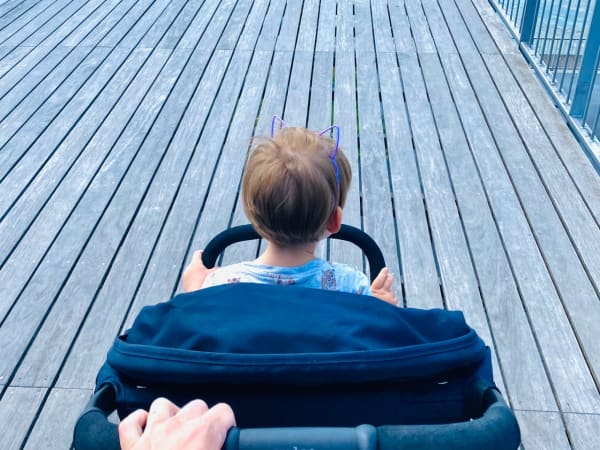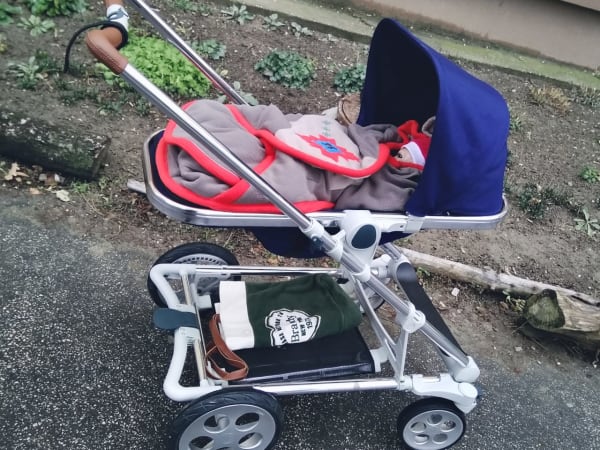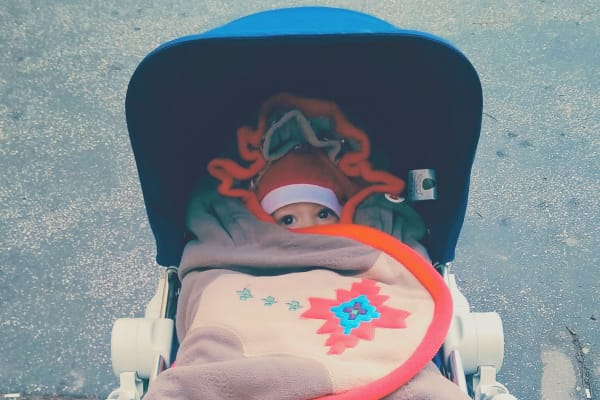When and how to transition from a newborn pram/carrycot (or car seat) to a pushchair/seat unit?

TL;DR: There's no one perfect way to approach this. It is incredibly individual. The best you can do is to understand different types of strollers, your own lifestyle, and the way you push your child around, and your own feelings and knowledge of your little one. All that should, of course, be limited by your budget.
When is the right time to transition to the next stage - the seat unit of a pushchair or a buggy?
Each and every child - as well as each mother - is different. That is why the use (or the refusing) of a stroller can happen in a different way. There are babies that can sleep half the day in a bassinet, and there are those that are constantly unhappy or crying. Sometimes, that can improve after they pass from the carrycot to the seat configuration.
This was the case of my first, unfortunately.


The time of passing on from a newborn setup of a pram/bulky stroller system to a pushchair is different from family to family. When it's high time to do so? And what to watch out for?
The official stance of norms and medical authorities
The "traditional" standard states the suitability of pretty much any seat unit, even though not offering a lie-flat feature, 6 months and up. This is given by laws and norms that do not always take into account the reality, which is that it is very rare, actually, for a six-month-old child to sit up by itself - without help. It is, however, true that six months is usually the age of a baby that passes from a bassinet to a sitting part of the stroller. It is not, usually, because of them sitting up, but because they either grew up from the carrycot (that became too small for them) or because they are bored with not seeing the outside anymore.
Mainly in western countries, it is relatively normal for parents to not even use a carrycot (at all!). The truth is that a baby CAN be put into the seat unit pretty much right from birth, but ONLY if the seat reclines fully, offering a lie-flat position for the newborn child. To make the child sit up or even be inclined considerably while the child didn't sit up without outside help, however, hurts the baby's spine and neck, putting too much strain on body areas that are not strong enough yet. This might cause problems (like scoliosis or back/neck pains) later on (the time this shows varies from a few years to 10 to 20 years plus).
Parents, be patient and don't speed this process up; let the child grow into that. It will sit enough in its life. Even in 20 years, it will still be your child, and you don't want an adult child of yours to suffer from back pains then, either.
A bucket seat or a lie-flat seat? What is better?
The pushchairs from stroller system sets - as well as those purchased separately - can be divided into multiple categories. One of the main ones is the type, shape of the seat itself, creating the question in many parents' minds: is a bucket seat better, or should I go for a lie-flat seat unit? There are pros and cons for each type, making none of these types better than the other - it always depends on circumstances, preferences, and other things important in your lifestyle. Do read this article about ergonomically shaped, bucket-style seat units to know more; in the meantime, I will only state the obvious difference, which is: the bucket seat reclines as a whole, in its L-shaped (some say V-shaped) so-called anatomical shape. On the contrary, a lie-flat seat offers an individual seatback and leg rest adjustment.
The important thing here is that because of its shaped nature, a bucket-style seat (e.g., Bugaboo strollers feature that in most of their models) is not a from-birth seat as it is. You CAN use it from birth, actually, but you will need a wedge - a wedged insert flattening up the seat's surface to be used for smaller babies. Otherwise, they'd look lost in the seat unit.
The more traditional lie-flat seat (like a Cybex Pram's) can be, on the other hand, used right from birth (And also for babies napping on their tummies), but often feels more slanted, causing the child slide down sometimes. Also, it is not as anti-reflux as a bucket-seat is.
Even medical experts cannot agree on what is better, health-wise. A half will swear a lie-flat is the only way to go; the other half, on the other hand, recommends a shaped bucket seat because of its anatomic properties similar to the child's position when in mommy's belly.
The general advice is, still, the same for bucket- as well as for non-bucket seats: your baby has to be put in the reclined if not sitting by itself just yet.
A reversible or a forward-facing-only pushchair?
The advantage of a reversible seat stroller is, of course, its capability to both world-face AND parent-face, meaning bonding and an overview of your baby. This is even more important for first-time parents and the time right after a carrycot. However, it comes with a few disadvantages - a higher price, a higher weight, most often a bulkier fold and a shorter canopy, and a less spacious seat. As the seat unit has to have the attachments and a whole frame to be able to reverse, it will simply be shorter, narrower, and without the extra space to the canopy.
A world-facing-only stroller sport usually wider seat space and often a longer one as well (at least considering the whole space up to the canopy). Also, the hood is usually larger, and the frame a bit more lightweight as well as more compact-folding, as the seat is 'hanged' right on it. Forward-facing pushchairs are usually a choice of multiple-time mothers or of those less demanding that need something lighter and more affordable, knowing the child would use the rearward-facing position only for a couple of months.
General pieces of advice
Just like when choosing the right first pram for your newborn, even the second transition pushchair of the later time is a choice that takes quite some consideration of your lifestyle, rational criteria, and personal preferences. You should always listen to yourself as well as your baby's needs and, i.e., leave the baby in the bassinet as long as it wants to be there and fits inside (or not, if it doesn't work for him or her). Don't let yourself be pushed into something that worked for your friend/mother/aunt/anybody around just because they think it's best. You, as a mom/dad, know your child and your life situation the best, and you should own that. Your baby and your life are unique and different from any other, just go with it as you feel and see it fit.
ALWAYS take the budget and the stroller price into account - the approximate (or the highest possible) price tag should be set as a first thing. It also makes sense to think of used strollers if you need yours to be affordable while needing something good, quality, and long-lasting. Any specific need, like a very all-terrain, a very roomy, or any other "very," will usually come at a higher cost as the materials need to be that much better. And vice versa, a lower price will always mean a compromise of features or quality.
A lightweight, compact stroller will never be great for terrain, and an all-terrain model will need large wheels and a durable chassis, making it heavier and bulkier.
If you need to load and unload your buggy in and out of the car multiple times a day, it doesn't matter as much that you'd perhaps like a stroller good for harsh terrain. The priority of your stroller will have to be a low weight and a small-size fold, even if the non-all-terrainness will be a price to pay for that. If your child doesn't sit without you sitting it up, it doesn't matter that the neighbors' kid of the same age sits in its stroller, it is a different child in a different stage of development, and yours, non-sitting, still needs a reclined position. The advice here is - don't compare, live your life and accept it as it is.
My children, strong boys, btw, sat up by themselves around 10-11 months of age without help. They missed nothing and are perfectly healthy. Don't worry, the children will sit enough when going to kindergarten and later, school 😉
My last (but not least!) piece of advice when passing to a pushchair is - listen to your feelings, not to others' rants. If your baby's happy in a rattly urban umbrella stroller, no bother thinking about a larger all-terrain pram. If the child asks and turns to mummy every time, a reversible stroller is definitely worth it, even if it's more expensive, less roomy, and a bit more bulky.
Do listen to others' well-meant advice for inspiration, but always think for yourself and your family ^_^
